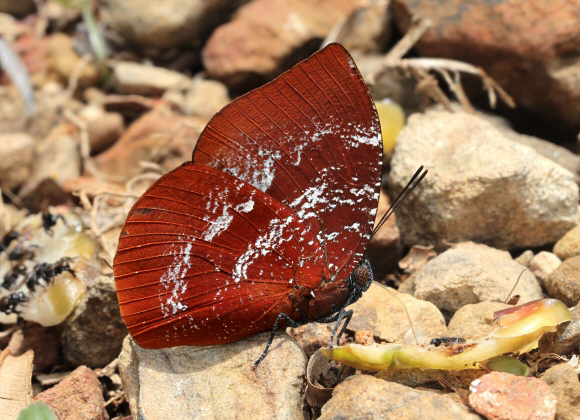 Memphis laura caucana, Tatama NP, Colombia – Chris Orpin
Memphis laura caucana, Tatama NP, Colombia – Chris Orpin
Introduction
The tribe Anaeini comprises of 87 neotropical species in the genera Coenophlebia, Consul, Anaea, Polygrapha, Memphis, Siderone, Fountainea and Zaretis. The butterflies are characterised by having a very rapid and strong flight. They have stout bodies, falcate wings, and on the upper surface are generally black, marked with bands of orange, bright red, or lustrous blue according to species. The undersides of all species in the Anaeini are cryptically patterned and bear a strong resemblance to the dead leaves, tree bark or boulders on which they settle.
The genus Memphis includes 60 species, all restricted to the neotropical region. The forewings of all species have a falcate apex, and a concave dorsum. In many species the tornus of the forewing is very acute.
The male of Memphis laura is black on the upperside, with metallic blue scaling over the basal half of the wings, and broad suffused orange-brown borders. The female is metallic blue with a broad white diagonal band across the forewing, and a black apex. The undersides of both sexes are very similar but the female has tailed hindwings.
Memphis laura is distributed from Costa Rica to Colombia. There are 4 subspecies. Memphis laura caucana is endemic to Colombia.
Habitats
Memphis laura occurs in rainforest and cloudforest at elevations between about 200-1800m.
Lifecycle
I have no data relating specifically to laura, but the following account describes the lifecycle of a typical Memphis species :
The eggs are smooth and globular. They are laid singly on leaves of the foodplants, which according to species include Piperaceae, Euphorbiaceae, Lauraceae, Monimaceae and Annonaceae.
The caterpillars are cylindrical, tapering towards the bifid tail, and covered with tiny granulations or very short bristles. They are typically green or brown, marked with a series of fine longitudinal lines. The head is large, and bears a crown of short pointed tubercles. When small, the caterpillars make frass-chains ( chains of dried droppings ) on the tips of leaves. When older they live within leaf tubes made from rolled up leaves bound together with silk, and only emerge when feeding.
The chrysalis of all species is stocky and barrel-shaped, with a very large thoracic section, and highly compressed abdominal segments. It is typically green or brownish, lightly marbled, and is suspended by the cremaster from a leaf or stem.
Adult behaviour
Like other Memphis species this butterfly spends most of its life in the upper canopy. It is however strongly attracted to rotting fruit, mammalian dung or carrion on the forest floor.
The wings are always kept tightly closed when the butterflies are feeding. If disturbed they fly up onto nearby understorey foliage. They typically spend several minutes there and often open their wings fully to bask in the dappled sunlight.
